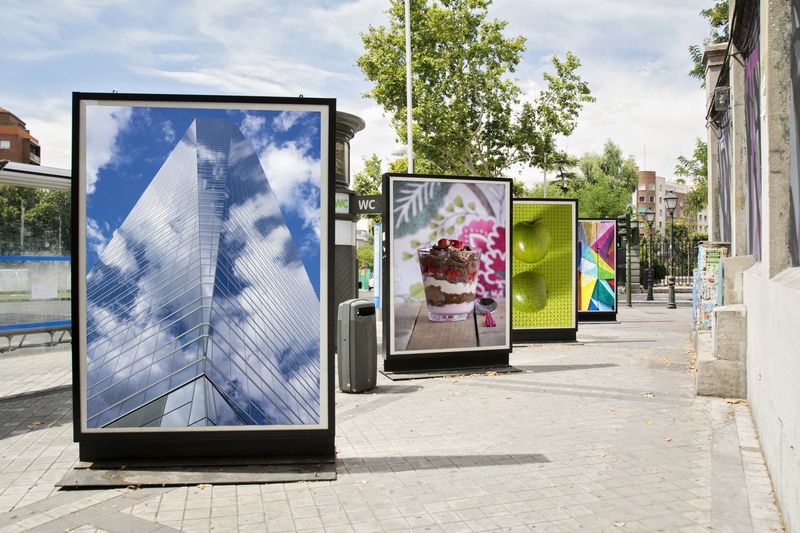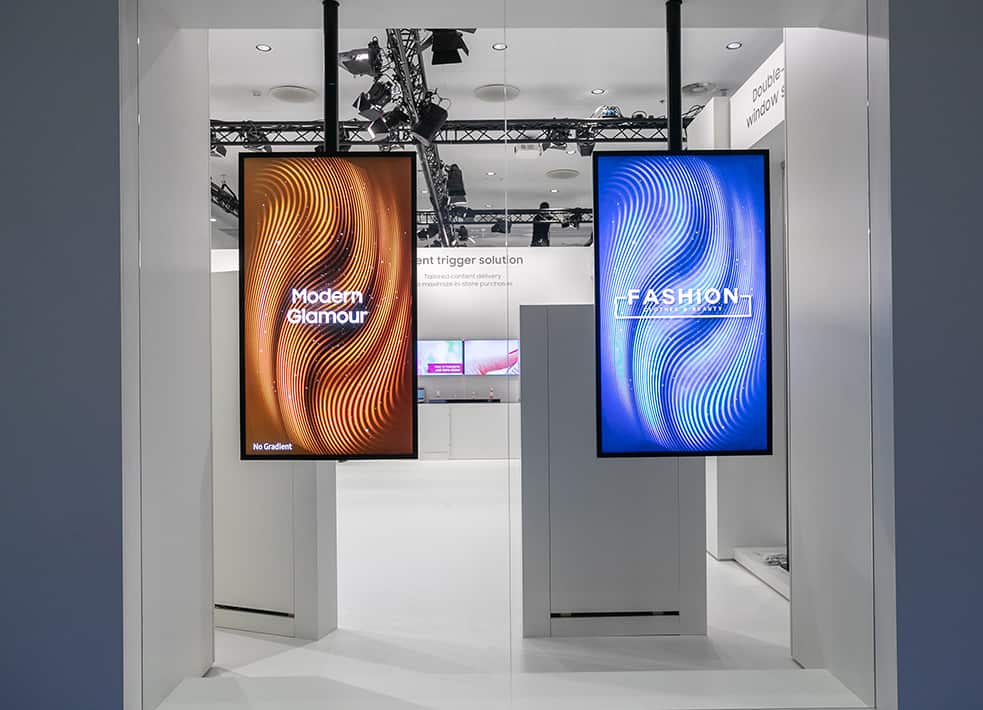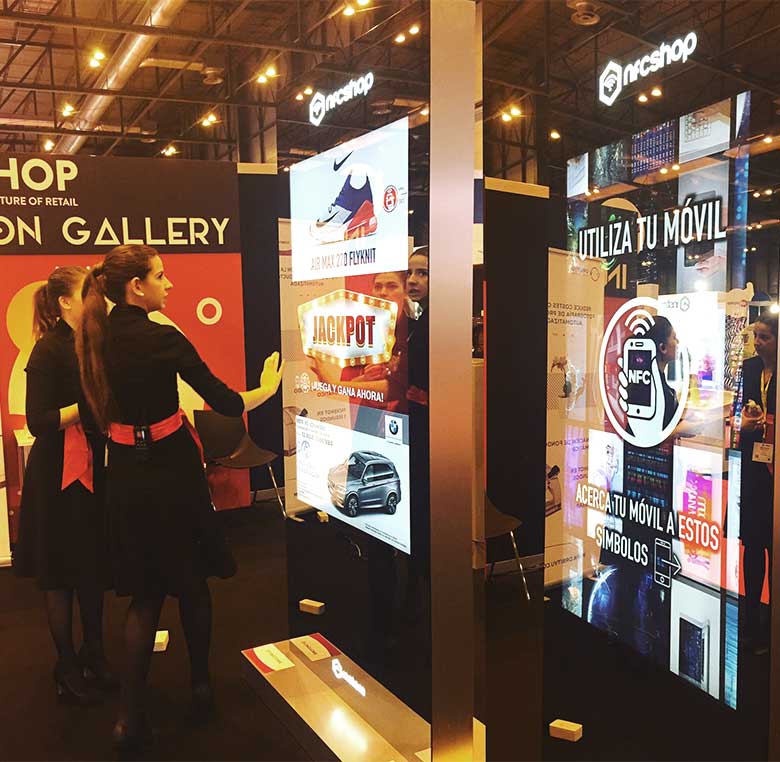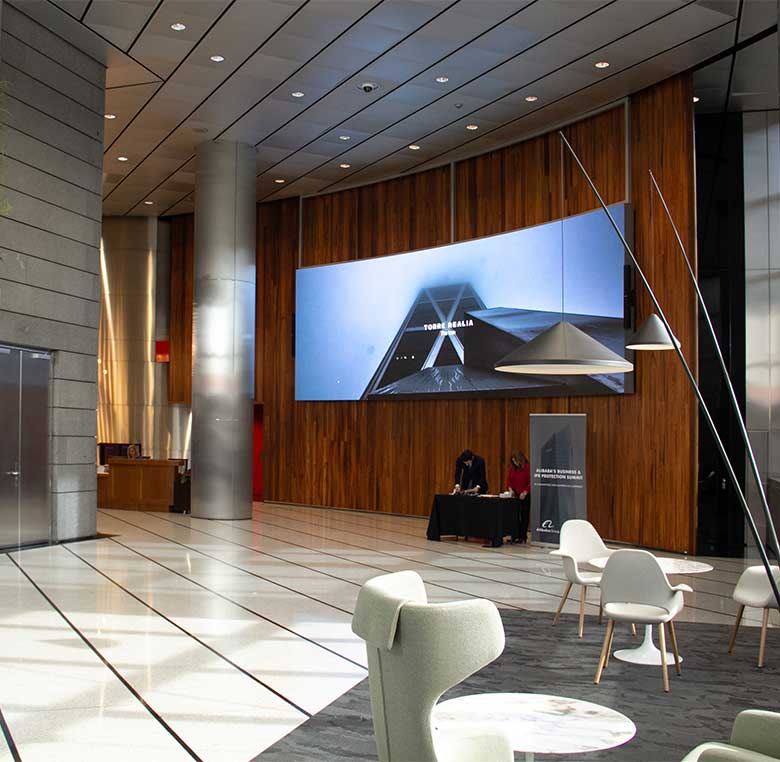
One of the 21st century’s revolutions in the world of retail and advertising is digital signage.
This type of signage can be defined as the dissemination of digital content through a screen or network of screens, remotely controlled, where various types of content such as images, videos, texts, social media content, etc., can be broadcast.
Therefore, digital signage is a great alternative for your advertising project because, unlike static signage, it allows real-time content updates and medium/long-term cost savings on printing. These digital campaigns can be displayed on screens, touch panels, projectors, or digital totems.
A digital signage project for your business can be very beneficial in aspects such as:
Using digital signage as an advertising tool results in up to 30% more public attention capture than traditional systems.
Seventy per cent of purchasing decisions are made at the point of sale. Therefore, promoting sales through attractive and impactful advertising, such as digital signage, can exponentially increase your revenue.
Moreover, the message reaches the public better and faster, enhancing recall. Eighty per cent of people who receive a message from these devices tend to remember it much better and for a longer time. This way, we can also work on the “Top of Mind” strategy, raising your brand’s positioning.
Another strong point of this signage system is the great implementation capacity of digital supports. For example, when performing space signage, you can combine it with entertainment content, reducing the perception of waiting time by up to 50%.
But what types of digital signage can you use in your business? Depending on the location, we can distinguish two major types of digital signage: Indoor Digital Signage and Outdoor Digital Signage.
Outdoor Digital Signage

Outdoor advertising on digital billboards in the streets of Valencia
As the name suggests, these are screens usually located outside or in shop windows, differing from indoor ones in size, image quality, brightness, and, in some cases, the material they are protected with. This type of digital signage, when placed in outdoor spaces, always requires a protective casing or screen to prevent damage from weather conditions.
It is also important to consider the ambient light of the installation site. Ignoring this will hinder the screen content’s impact, or it may not even be visible. Hence, different brightness levels exist depending on the screen type, designed to ensure your message doesn’t get lost.
Size and viewing distance are also critical factors, as the image quality will vary significantly. A screen placed on a roadside billboard will need a much larger pixel size than a shop window, which will be viewed up close and needs more detail.
The most widely used screens in this system are LEDs: as mentioned earlier, they allow for larger-scale screens and can be maintained for longer periods without losing quality.
Generally, they are used to convey information to users about your business, brand, services, products, offers, events… Even generating new needs through impactful marketing work.
We can also use this type of signage in formats such as totems, OPI supports, or illuminated signs. They are usually located in public places with high foot traffic, such as bus stops, city access points, squares, facades, shop windows, etc.
These signage systems often require a high investment due to the need for outdoor protection systems and the higher cost of technology. However, you can achieve strong customer attention and experience impact in return.
Indoor Digital Signage
These digital signage systems were the first to be installed at points of sale within the digital transformation the retail world is experiencing.
They are a great resource because digital signage allows more direct contact with the customer, enabling you to expand the range of content, making it more specific and closer to the consumer. It is even possible for users to interact, select, and directly access the content they want through these screens. This makes their influence much more direct and persuasive, favouring purchases.

Locations for digital signage. LKBITRONIC. 2020
With this system, we can provide customers with much more detailed information about our products or services’ features, offers, and prices.
Internet connectivity for interaction and content modification will be essential in these indoor digital signage systems. The requirements will be much more accessible, as once the digital signage is installed, generally no other protections are needed.
The most common use for indoor digital signage is LCD screens, which allow more optimal use of fluctuating content.
These signage systems also require much lower investment, allowing access to a wider range of budgets.
We can find this type of signage in formats such as illuminated signs, shop windows, indoor digital signs, etc.
Other types of screens include:

Totem: These screens are placed outdoors on mupi-type supports, in a vertical position. They are best suited for advertising in high-traffic areas.

Videowall: A modular set of screens where the same or different content can be projected. They are often used in large spaces such as fairs, sets, or leisure spaces, preferably indoors.

Outdoor or semi-outdoor LED: These are the largest and can be considered an alternative to billboards. Large totems of these screens can be seen along roads. They are also used on facades or rooftops, and the image quality is very high.
Highlight Your Product: Show a video of a product near its shelf so users can see it in action. Show product features, prices, materials, stock levels, etc.
Boost Your Branding: Tell your company’s story through simple but attractive storytelling videos. Show your animated logo. Encourage your customers to engage with your brand by displaying the most popular posts from your social media, inviting them to participate with a hashtag.
Advertise or Allow Advertising: Advertise your brand in public spaces using other digital signage companies or let other businesses advertise in your spaces for additional income.
Promote Internal Communication: Simplify your company’s internal communication with automatically updated data to ensure your staff can communicate quickly and efficiently. Provide your staff with the latest information through sales communication and KPIs, fostering high performance and motivation. For example, displaying meeting room availability and booking options directly from the screen can help employees.
Keep Your Audience Entertained: Give your customers reasons to stay longer; you can show them sports, news, magazine videos, presentations, YouTube videos… This way, you reduce waiting time and improve the customer experience.
So far, we have seen how digital signage systems can increase our sales and promote consumption, attention, and interest in our business through visual impact and interaction. But is it possible to also access customer opinions and preferences? How do you think this would affect your benefits, development, and business plan?
Smart Data is a digital system that allows obtaining specific consumer data, achieving one of the most sought-after objectives by all companies: information about their customers. When the purchase is made online, obtaining buyer information is easy through different programmes or website management systems. But how can you get customer data when they buy in your physical store?
Smart Data is an innovative advertising format that combines data usage and business intelligence to create smart digital content at points of sale. Through cameras installed in your establishment, you can obtain important data such as: analysing customer profiles by gender and age during different time slots and days, identifying hot zones with heat maps, knowing the customer journey in your stores, and discovering recurring profiles.

The use of Smart Data as a content generation tool.
With a CMS (content management system) management software, you can manage your digital signage content and use artificial intelligence. With this system, you will analyse your business’s offline data (sales, inventory, traffic…) and external data that may affect it (weather, sporting events…).
With all this information, you can develop a predictive model of your target audience’s behaviour and personalise the content on your screens based on customer characteristics. This anonymous information allows real-time interaction with your store’s traffic, creating a unique experience for your buyers.
Technology (Big Data & Analytics and AI) is revolutionary in the industry. More and more companies are implementing them in their establishments, offering a value proposition and optimal experiences, much closer to customer needs.
Data analysis and artificial intelligence solutions allow us to identify potential customers and enable personalisation and adaptability of the experience to their needs, identifying the most effective means for interaction.
It will also allow developing effective improvement strategies in different business areas such as supply chain and supplier management, inventory management, marketing, advertising, and customer relationship management. All this collected information (KPIs) will exponentially increase the business’s profitability, efficiency, and productivity.
Data analysis or Big Data allows us to create an effective marketing and digital content strategy with quality content, with measurements and analysis of consumer behaviour. Therefore, Big Data will allow you to create personalised strategies adapted to your customers’ needs. Who could have imagined this years ago, right?
The arrival of coronavirus has affected all aspects of our lives, changing people’s behaviours, especially in physical stores and points of sale.
Safety and health have necessarily become top priorities in physical stores. This has led all companies to evaluate their sales strategies and develop and implement new marketing strategies that adapt to this new reality.
The direct consequence has been social distancing and the acceleration of new technologies to adapt and condition businesses to revive their sales.
Physical stores are innovating more than ever to meet customer needs.
We propose three proven strategies to increase sales in the retail sector during this situation:
As you can see, the digital future we thought was distant a few years ago is already here, and you need to get on the digitalisation train if you don’t want your business to be left behind. You must aim to improve the customer experience in-store, and digital signage is your ally in this. If you manage to get your customers to interact with the screens, you will get them closer to your brand and thus retain them.
You may also be interested
open
08:00 AM-18:00 PM Monday – Friday
08:00 AM-18:00 PM Monday – Friday